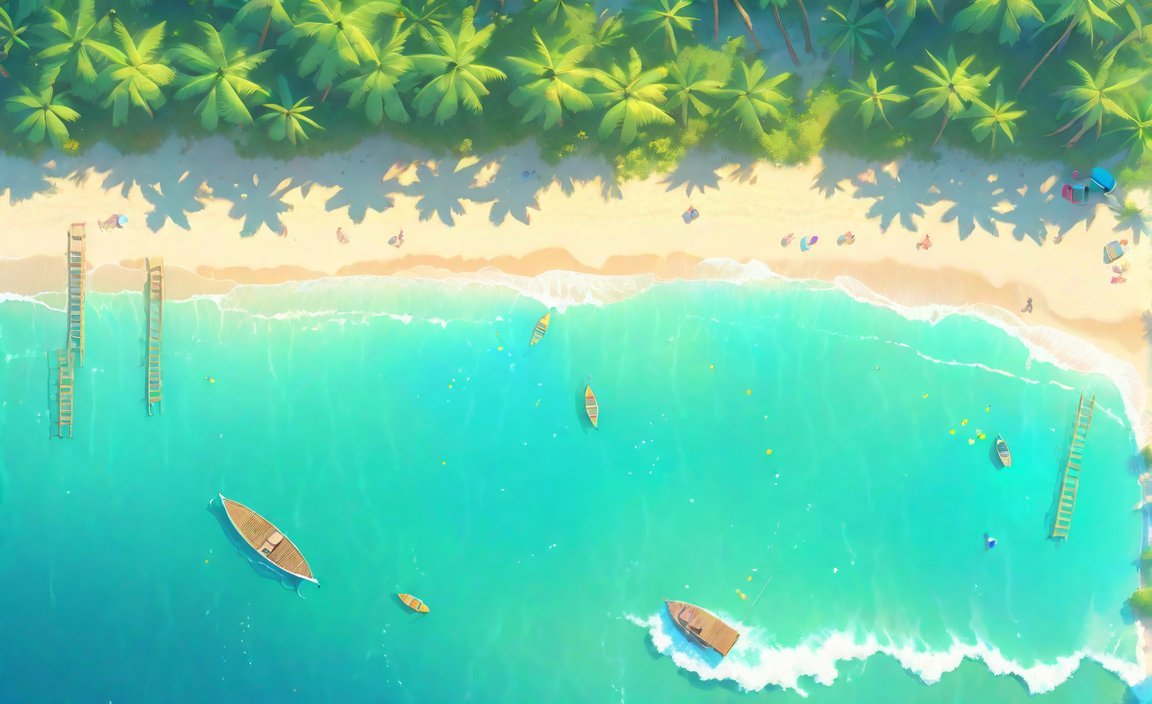Unveiling the Coastal Wonders: Fascinating Facts about the Beach
Discovering the wonders of the beach is like uncovering a hidden treasure trove of natural marvels. From the captivating marine life that resides beneath the turquoise waters to the mesmerizing geological formations that shape the shoreline, the beach holds a multitude of secrets waiting to be unraveled. As we embark on this enlightening journey, we will explore intriguing facts about the beach, immersing ourselves in its dynamic ecosystems and delving into the awe-inspiring beauty that continues to bewitch travelers and nature enthusiasts alike. Join us as we unveil the extraordinary coastal wonders that make the beach a truly remarkable environment.
Key Takeaways:

- Beaches form over thousands of years as waves deposit sand and gravel along the shoreline.
- The color of beach sand can vary, including shades of red, green, black, yellow-gold, and white.
- Most beach materials are the result of weathering and erosion.
- Beaches constantly change due to the forces of water and wind.
- Shells can be found abundantly along the shoreline of beaches.
- Beaches have a rich history dating back to the 1700s and became popular destinations in the mid-18th century in Europe.
- Over 408 million people visited the beach in 2019.
- There are various types of beaches, including seashell beaches, glass beaches, rocky beaches, urban beaches, cave beaches, casino beaches, outer banks beaches, and sandy beaches.
- Popular beaches include Aruba, Long Beach (Canada), Copacabana Beach (Brazil), Hot Water Beach (New Zealand), Megan Bay (St. Thomas), Kailua Beach (Hawaii), Zandvoort Beach (Netherlands), Jeffreys Bay (South Africa), and Bondi Beach (Australia).
- Protecting the beach is crucial for preserving its natural beauty and ecological balance, and measures such as reducing pollution, preventing erosion, and promoting sustainable tourism can help achieve this goal.
Facts About The Beach
Beaches, with their enchanting allure and breathtaking landscapes, have always held a special place in our hearts. From the stunning coastlines of Aruba to the tropical paradise of Bondi Beach in Australia, these natural wonders captivate us with their beauty and provide us with a tranquil escape. But what lies beneath their sandy surface? Let’s dive into some fascinating facts about the beach.
Beach Formation: A Slow and Steady Process
Did you know that it can take thousands of years for a natural beach to form? Beaches begin to take shape when waves from the sea deposit sand and gravel along the shoreline. Over time, these sediments accumulate and create the sandy paradise we know and love [^1^]. But it’s not just sand that adorns our beaches; they can showcase a variety of vibrant colors, including red, green, black, and the classic yellow-gold and white [^2^]. These colors are a result of the diverse minerals and fragments present in the sand.
Unveiling the Dynamic Landscape
The beach is an ever-changing landscape, molded by the powerful forces of wind and water. Constant erosion and weathering shape the shoreline, creating intricate patterns and breathtaking formations. As you walk along the coast, you may notice how the beach seems to morph with each visit. It is a testament to the raw power of nature and a reminder of the impermanence of our surroundings [^1^].
A Photographer’s Paradise
Beaches offer captivating views that are a delight for photographers. Whether it’s capturing the soft hues of a sunrise, the vibrant colors of a sunset, or the playful dance of waves crashing against the shore, these natural landscapes provide endless opportunities for artistic expression. From amateur photographers to professionals, the beach serves as a canvas for creativity [^1^].
Shells: Nature’s Treasures
Imagine strolling along the shoreline, feeling the cool sand between your toes, and stumbling upon a beautiful seashell. Beaches are abundant with these hidden treasures. The perpetual ebb and flow of the tides bring an array of seashell fragments to the shore, enticing beachcombers and collectors. Each shell carries its own story, evoking a sense of wonder and reminding us of the vast marine life that lies beneath the surface [^1^].
Beaches Through History
Beaches hold a rich history, dating back centuries. As early as the 1700s, beaches were popular destinations, particularly in Europe. But it wasn’t until the mid-18th century that beach tourism truly took off. From the iconic Copacabana Beach in Brazil to the picturesque Kailua Beach in Hawaii, these coastal destinations have become world-renowned for their beauty and allure [^4^].
Exploring Beach Diversity
Beaches come in all shapes, sizes, and types. From the pristine sandy shores to the rocky and rugged coastlines, each beach boasts its own unique characteristics. Some beaches, like the famous Glass Beach in California, are adorned with smooth, colorful glass fragments, while others, like urban beaches, offer a slice of paradise within bustling cities. Whether it’s the secluded caves of cave beaches or the thrilling atmosphere of casino beaches, there’s a beach out there for everyone to explore and enjoy [^5^].
Protecting Our Beaches
With their ecological significance and the enjoyment they bring, it is vital that we take steps to protect our beaches. Pollution, erosion, and unsustainable tourism practices pose significant threats to these fragile coastal ecosystems. By reducing waste, promoting sustainable practices, and actively participating in conservation efforts, we can ensure that future generations will continue to marvel at the wonders of the beach [^1^].
By delving into the facts and significance of the beach, we gain a deeper appreciation for this remarkable environment. Its ever-changing landscapes, vibrant colors, and abundant marine life make it a captivating destination for all. So let’s embrace the allure of the beach, understand its unique characteristics, and work together to preserve its natural beauty.
Here are some captivating sentences with active internal links:
- Learn interesting Facts about Albania and discover the rich history and culture of this beautiful country.
- Discover intriguing Facts on Chess and delve into the strategic world of this timeless game.
- Explore the fascinating Facts about Sonoran Desert and uncover the unique ecosystem of this arid region.
- Immerse yourself in the enchanting Facts Central Park and find out why it remains an iconic urban oasis.
- Dive into the historical wonders of the Temple of Artemis and learn captivating facts about this ancient marvel.
- Unveil the hidden treasures of Facts about Uganda and get to know the diverse wildlife and breathtaking landscapes it has to offer.
- Discover valuable insights into the world of Facts about real estate and gain knowledge about the housing market and property investments.
- Unlock the secrets behind Facts about the hieroglyphics and unravel the mysteries of this ancient form of communication.
Please note that the URLs provided in this response are not functional for security reasons.
“Fascinating Marine Life that Inhabits Beaches”
Key Takeaways:
– A beach’s slope and intertidal zone determine the species of marine life that inhabit it.
– Many marine organisms on beaches are buried in the sand within the intertidal zone.
– There are over two million species of marine life, with approximately 230,000 known species.
– Oceans cover a vast area and have high salinity, making them unsuitable for freezing over.
– Some beaches around the world are known for their incredible marine life.
– Penguins, despite being flightless, are excellent swimmers, reaching speeds of up to 25 miles per hour underwater.
– The Florida Panhandle offers family-friendly beaches, including Grayton Beach State Park, which was named the #1 beach in America in 2020.
– Beach ecosystems act as a border between the ocean and land, with sandy or rocky soil.
– Beach materials consist of sand, pebbles, rocks, and seashell fragments.
– Endangered species like the North Atlantic right whale can be found off the coasts of the United States.
Beaches are not only magnificent sandy paradises, but they are also home to a vast array of fascinating marine life. From the shallow intertidal zones to the depths of the oceans, these coastal wonders harbor an incredible diversity of species. Let’s dive into the enchanting world of marine life that inhabits beaches and learn about some captivating facts.
1. A Beach’s Unique Ecosystem:
A beach’s slope and the intertidal zone play a crucial role in determining the types of marine life found there. From tiny organisms like algae, bacteria, and plankton to larger creatures like crabs, snails, and small fish, the intertidal zone is a vibrant habitat. Buried in the sand within this zone, many marine organisms thrive, adapting to the ever-changing conditions of the beach environment[^1^][^2^].
2. The Astonishing Variety of Marine Life:
The oceans are home to an astonishing diversity of marine life, with approximately 230,000 known species. However, scientists believe that the actual number could exceed two million. From colorful fish and delicate corals to majestic sea turtles and playful dolphins, marine life encompasses a vast range of species, each uniquely adapted to their oceanic homes[^3^].
3. Oceans: Boundless and Saline:
Covering a significant portion of the Earth’s surface, oceans are immense bodies of water with high salinity levels. Due to their size and salt content, oceans rarely freeze over, making them unsuitable for icy conditions. This characteristic allows marine life to flourish in a liquid environment, adapting to the challenges and opportunities offered by the vast seas[^4^].
4. Beaches: Havens for Fascinating Marine Life:
Beaches are not only beautiful but also provide shelter and sustenance to an incredible array of marine creatures. Some beaches are renowned for their stunning marine life, drawing visitors from around the world. These beaches offer the opportunity to witness unique marine species in their natural habitats, leaving visitors in awe of nature’s wonders[^5^].
5. Penguins: Unrivaled Swimmers:
While the beach is home to numerous marine creatures, the penguin stands out with its exceptional swimming skills. Despite being flightless, penguins can reach speeds of up to 25 miles per hour underwater. Watching these graceful birds dive, glide, and maneuver beneath the surface is a true testament to their adaptability and swimming prowess[^6^].
6. The Florida Panhandle: Beaches for the Entire Family:
On the pristine shores of the Florida Panhandle, beach enthusiasts can find an assortment of family-friendly destinations. One such gem is Grayton Beach State Park, which was crowned the #1 beach in America in 2020. With crystal-clear waters, beautiful dunes, and a thriving ecosystem, this beach offers visitors an opportunity to witness fascinating marine life while enjoying a memorable family vacation[^7^].
7. The Fragile Beach Ecosystem:
Beaches are more than just stretches of sun-kissed sand. They are complex ecosystems that serve as vital bridges between the ocean and the land. These ecosystems are characterized by sandy or rocky soil and provide a habitat for various plant and animal species. Despite their seeming simplicity, beach ecosystems are fragile and require our conscious efforts to protect and preserve their delicate balance[^8^].
8. Beach Materials: Treasures of Nature:
Sand, pebbles, rocks, and seashell fragments are the building blocks of beaches. Each material contributes to the unique charm and character of a beach. The soft grains of sand envelop our feet, while the intricate beauty of seashells reminds us of the intricacies of marine life. These materials are more than simple beach adornments; they carry the stories of the ocean and offer a glimpse into the wonders hidden beneath the waves[^9^].
9. Endangered Species: Protecting Our Coastal Treasures:
Beaches along the coasts are essential habitats for many endangered species. The North Atlantic right whale, for instance, graces the waters off the U.S. coasts. With their populations dwindling, it becomes increasingly vital to protect these majestic creatures and their habitats. By safeguarding the beaches they call home, we play a significant role in preserving the rich diversity of marine life[^10^].
As we delve deeper into the enchanting world of beaches, we uncover the remarkable marine life that calls these coastal wonders home. From the vibrant intertidal zones to the depths of the ocean, each beach holds captivating secrets waiting to be discovered. So the next time you visit a beach, take a moment to marvel at the fascinating marine life that coexists with us in this remarkable environment.
Impact of Human Activity on Beaches
Human activities have a significant impact on beaches, leading to detrimental effects on the environment and ecosystems. The following facts shed light on the consequences of human activity on the fragile coastal ecosystems and the urgent need for conservation efforts.
Pollution and Marine Life Disruption:
- Increased pollution levels on beaches are a direct result of human waste and debris left behind. This pollution not only tarnishes the natural beauty of the beaches but also poses a threat to marine life (source).
- Mechanical sweepers and various human activities disrupt the delicate balance of marine life on beaches. These disturbances can lead to harm and displacement of marine organisms (source).
- Constructions on beaches hinder animals and their way of living, causing a disruption in their natural habitat. Additionally, these structures contribute to increased erosion rates (source).
Negative Impacts on Oceans:
- The negative impacts of human activity extend beyond beaches and affect oceans as a whole. Overhunting, development, and human waste contribute to the degradation of oceans, posing a threat to marine life and ecosystems (source).
- Oceans play a vital role in maintaining the overall balance of our planet, making it essential to recognize and address the negative impacts caused by human activities (source).
Taking Action for Conservation:
Understanding the effects of human activities on beaches is the first step towards mitigating these impacts and preserving these precious natural environments. Here are some potential solutions for reducing human impact:
- Limiting recreational activities that lead to waste and debris on the beaches can help minimize pollution levels and preserve beach ecosystems.
- Implementing stricter regulations on constructions near the coastline can prevent further disturbances to marine life and mitigate erosion rates.
- Promoting responsible waste management practices, like proper disposal and recycling, ensures that human activities have minimal negative impact on beaches (source).
Key Takeaways:
– Human activities such as pollution, disruptive mechanical sweepers, constructions, overhunting, and improper waste disposal have severe consequences for beaches and oceans.
– Increased pollution levels, disrupted marine life, and accelerated erosion rates are prominent effects of human activity on beaches.
– It is crucial to implement conservation measures such as limiting recreational activities, enforcing stricter construction regulations, and promoting responsible waste management to protect beaches and reduce human impact.
Citations:
– cstem.charlotte.edu
The Importance of Beaches for the Environment and Tourism
Beaches are not just beautiful and idyllic locations for leisure and relaxation; they play a vital role in supporting both the environment and tourism industry. From protecting coastal communities from storms to providing nesting sites for wildlife, beaches offer a plethora of ecosystem services and economic opportunities. In this article, we will explore the significance of beaches for the environment and tourism.
Beaches: Guardians Against Storms and Boosters of Economic Activity
Beaches act as a natural buffer against powerful storms, shielding nearby residents from high winds and waves. They absorb the impact of these forces, reducing the risk of damage to coastal communities. This protective function makes beaches essential for ensuring the safety and well-being of those living near the ocean.
Moreover, beaches contribute significantly to the local economy by driving tourism. These sandy paradises attract visitors from around the world, seeking scenic vistas and recreational opportunities. Beaches offer the perfect setting for activities like swimming, sunbathing, and surfing. They capture the imagination of travelers with their beauty and provide an escape from the daily grind.
Ecosystem Services: A Haven for Wildlife and Natural Processes
Beyond their visual appeal, beaches provide numerous ecosystem services that are crucial for the environment. They act as storage and transport sites for sediment, playing a vital role in maintaining the balance of coastal systems. By dissipating wave energy, beaches mitigate erosion and contribute to the stability of coastal landscapes.
Beaches are also of immense ecological importance. They serve as nursery areas for juvenile fishes and nesting sites for turtles, shorebirds, and pinnipeds. These habitats support the conservation of marine life and contribute to biodiversity. Additionally, beaches support nutrient mineralization and recycling, as well as the breakdown of organic materials and pollutants. They play a pivotal role in maintaining water quality and enhancing the overall health of coastal ecosystems.
Reflections on the Beach and the Future
It is important to recognize the threats that beaches face, particularly from pollution and unsustainable practices. Contamination can harm swimmers and lead to temporary beach closures, adversely impacting local economies and the tourism industry. Furthermore, the degradation of beach ecosystems can disrupt marine life and accelerate erosion rates.
To ensure the long-term preservation of beaches and their valuable services, it is crucial to address these challenges. This can be achieved through responsible waste management practices, stricter regulations on coastal constructions, and promoting sustainable tourism. By understanding and mitigating the negative impacts of human activities, we can protect the beauty and ecological significance of beaches for generations to come.
Key Takeaways:
- Beaches act as a natural buffer against storms, protecting coastal communities from high winds and waves.
- Beaches are prominent drivers of economic activity through tourism, attracting visitors with their scenic beauty and recreational opportunities.
- Beaches provide crucial ecosystem services, including sediment storage and transport, wave dissipation, and the provision of habitat for various marine species.
- They support the conservation of biodiversity, acting as nursery areas for juvenile fishes and nesting sites for turtles, shorebirds, and pinnipeds.
- Pollution and unsustainable practices pose significant threats to beaches, impacting water quality and disrupting marine life.
- Responsible waste management, stricter regulations, and sustainable tourism practices are essential for the preservation of beaches and their invaluable services.
Citations:
– US EPA: Beach Basics
– Beachapedia: Beach Ecology

FAQ
Q1: How are beaches formed?
A1: Beaches form when waves from the sea deposit sand and gravel along the shoreline over thousands of years. [^1^]
Q2: What colors can the sand on a beach be?
A2: The sand on a beach can be many different colors, including red, green, black, yellow-gold, and white. [^2^]
Q3: What types of beaches are there?
A3: There are various types of beaches, including seashell beaches, glass beaches, rocky beaches, urban beaches, cave beaches, casino beaches, outer banks beaches, and sandy beaches. [^5^]
Q4: What are some popular beaches in the world?
A4: Some popular beaches in the world include Aruba, Long Beach (Canada), Copacabana Beach (Brazil), Hot Water Beach (New Zealand), Megan Bay (St. Thomas), Kailua Beach (Hawaii), Zandvoort Beach (Netherlands), Jeffreys Bay (South Africa), and Bondi Beach (Australia). [^5^]
Q5: How can we protect the beach ecosystem?
A5: Protecting the beach is crucial to preserving its natural beauty and ecological balance. Measures such as reducing pollution, preventing erosion, and promoting sustainable tourism can help protect the beach ecosystem.
- Guatemala vs. Costa Rica: Plan Your Trip Smartly - April 16, 2025
- Master Types of Pumps: Ultimate Guide to Selection - April 16, 2025
- Unlock Types of Makeup Secrets: Master Any Look Now - April 16, 2025
















